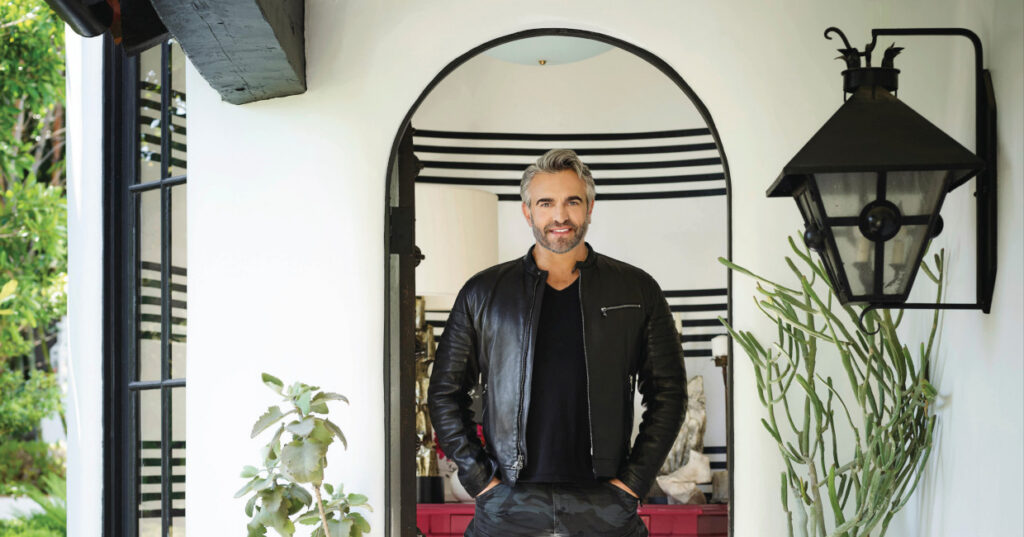Celebrating his 30th year in the design business, designer to the stars, Martyn Lawrence Bullard has published Star Style–a glamorous design tome and ode to the flamboyancy and exuberance of some of his most notable design work. Sophie Harper met with him in London to discover how 30 years in the industry has shaped his career.
Renowned for his design work on the homes of the rich and famous, as well as his unique take and glamorous flair within hotel design, Martyn Lawrence Bullard tells me his career path into interior design was completely unintentional. “I fell into the whole thing. I originally wanted to be an actor and I went to Hollywood at 21 thinking I was going to be a movie star, but I ended up working in a coffee shop instead!” He laughs.
Born and raised in the UK, Martyn grew up with theatrical influences from his father who was an actor and opera singer before becoming a businessman. “I actually started my career, without really knowing it at the age of 12 when I convinced my father to rent me a stall in Greenwich Market selling bric-a-brac that I would buy with my pocket money. I would run around buying cups and saucers, silver spoons, whatever I could afford that I thought was pretty, and I’d put it on my own stall and would wait for American tourists to come so I could spin a tale to sell them things! It was a hobby but it was a great way to make money, it was where I learnt how to put things together, what a hallmark was, how to determine where something came from, what period it was from – I learned the basis of who I am today on those market stalls.”
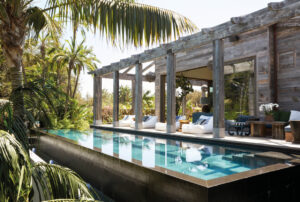
Following his school education, he joined the Lee Strasberg Acting Academy in London before heading out to California to chase the American dream. “After a while in LA and a few small parts, the producer from a movie I was in came for dinner at the house I was renting – I lived in this crazy little place which had previously been star dressing rooms for people like Charlie Chaplin and Judy Garland, so it had loads of creative energy. Anyway, he loved it and asked me if I would come over and decorate the offices for Hollywood Filmworks. I thought this is bizarre, I don’t know what I’m doing but maybe if I do it he’ll put me in another movie, so I went and did it.”
After finishing his work at Hollywood Filmworks’ offices, Martyn received an unexpected call from Liz Heller, the Executive President of Capitol Records, who had seen his design work and wanted him to do some work for her. “A month into the job she was getting married and her wedding planner overdosed. She called me in a panic, so I jumped in to help her. I didn’t know what I was doing, I was just throwing rose petals everywhere! The wedding was filled with every kind of star at the time and she insisted I stay for the ceremony. By the end of the day Cheryl Tiegs had hired me, nine months later I was on the cover of six magazines and suddenly I had a huge celebrity following.”
By the end of the year Martyn was working for Rebecca Romijn-Stamos, Christina Aguilera and Sigourney Weaver. “It was bonkers! And then within a couple of years it turned into even bigger names, Cher, Elton, it’s been an unbelievable journey.”
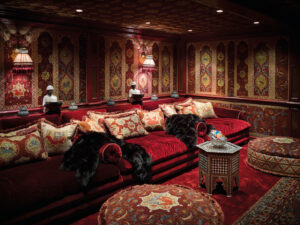
From A-lister homes to big hotel brands, Martyn had carved out a solid client base and was fast becoming a celebrity in his own right, with his own TV shows and product ranges. “Currently I’m working with Pink, Sylvester Stallone, I’m finishing the Four Seasons Residences in Los Angeles, I’m doing a new restaurant in LA for Master Chef Rick Bayless, I’m doing a redo of Sharon and Ozzie’s house, a new beach house for Ellen Pompeo and something for Machine Gun Kelly – it’s a real mixed bag!”
He puts his success down to the fact he doesn’t follow trends, instead preferring to create completely unique settings that are personal to each client. “I never wanted to be known for a particular style – I don’t want anyone walking into a room and saying, ‘hey this must have been designed by Martyn Lawrence Bullard’, I want them to walk into a room and say ‘wow, this is fabulous’. It’s really about getting to know my clients, getting to know their personality and understand who they are and what they love and really being able to capture their spirit, when someone walks into your house and says, ‘oh my God, this is so you it’s great!’, that’s the success.”
Martyn tells me how he brings character and unique design elements to each project by collecting pieces of artwork and furniture every time he travels (which is often!). “Much to the horror of my accountant, I’m a demented shopper!” He laughs. “Literally I got off the plane here and within 45 minutes was at the Decorative Fair and an hour later I’d bought a bookcase, library shelves, and a couple of 19th century Champagne baskets – what I’m going to do with them I’ve no idea, but I had to have them! I know somewhere along the line they’ll fit into someone’s design just perfectly. I can’t help myself, I shop everywhere I go, every country – it’s probably why I’ve got a bad back from lugging all this stuff around!”
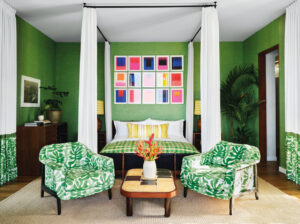
Looking around at our surroundings at Beaverbrook Townhouse’s Fuji Grill, Martyn gestures at the walls and admires the overall design by Nicola Harding, “I would have never thought I’d want to be surrounded by sage walls, but I love the way this feels.” He tells me how he finds hotel projects exciting to work on because of the impact the design has on the way guests feel. “The great thing with designing hotels is that they can be complete fantasy – it’s not necessarily what you would do or live with at home, a hotel is a place you go to to relax, to rejuvenate, to feel glamorous, feel sexy, feel enlivened.”
“For me public spaces are really important, they can be cosy or cool and experiential and the guest room itself is really important – you have to make sure you’ve got really comfortable beds, fabulous bedding, great lighting, a fantastic minibar experience; you want to make sure people feel really luxuriated in those spaces, it doesn’t matter if it’s a tiny room or a big room it’s all about the details.”
Martyn tells me that his approach to each new hotel project is to reflect on his own experiences of hotel stays. “I really look at a hotel in the essence of what have been my favourite experiences – what was the thing I loved most about a certain place – I take all that information and stick it in a cocktail shaker and blend our own cocktail. Another important factor is making sure a hotel feels correct to its location. Sense of place is incredibly important.”
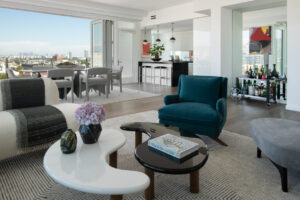
He talks about The Prospect – a hotel he owns in Hollywood – and how he wanted to give his guests a sense of being a Hollywood star themselves. “It’s a very small hotel, it’s very charming and it’s been designed to represent old school Hollywood. It was built in the 1930s and all these old movie stars used to live there so each room is named after one of the stars that either lived in or visited the building. We’ve got all this amazing memorabilia that I spent almost two years collecting that makes each room very individual. Every time you go back you can stay in a different room and have a different experience.
“One of the rooms is called the Mata Hari, which was one of Greta Garbo’s most famous movies, so it’s got this lovely chinoiserie flavour which has these sort of Chinese, Asian-inspired wallpapers and then these great 1920s style heavily fringed lampshades and dragon lamps – it’s mysterious, like the movie was – you can come and stay and feel like you’re Mata Hari! That’s what I love about hotel design, the freedom to be fanciful.
“It’s what distinguishes a hotel – you don’t want a beige room with uninspiring artwork hung on the walls that could be in Bognor, if you’re in Hollywood, you want to feel as though you’re in Hollywood – and I want you to feel like a movie star while you’re there.”
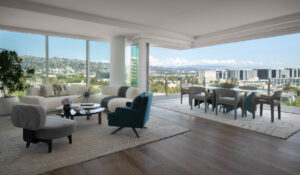
I ask him whether he feels it’s important for hotels to get that aspect of experiential design right and he nods enthusiastically. “Absolutely, even the big hotel brands that used to be all about a singular experience where you knew what you were getting are realising now that you can still offer that luxury experience and tick all those boxes, but they want you to know whether you’re in Hong Kong or London and so each place now has its own flavour.
“I think most designers are trying to create that feeling of romance or whimsy, and when a guest leaves and has memories of that feeling of a place, it brings them back and that’s what hotels want – returning guests – that’s why your offering has to be the very best it can be, and that should come at every price point.”
Leafing through Martyn’s book it’s difficult to maintain decorum rather than gawp at the pages displaying things such as the monochrome theme and 27 custom disco balls in RU Paul’s ballroom, the pretty femininity and playfulness of Kylie Jenner’s dining room and bedroom, and the sumptuously traditional Connecticut estate belonging to Tommy and Dee Hilfiger. It’s hard to believe that Martyn simply fell into design. I ask him what advice he’d give his younger self and other designers starting out, knowing what he knows now and he says: “I always say to young aspiring designers, it’s not about where you study, it’s about getting out and seeing the world. Travel. But travel doesn’t necessarily mean flying to far flung places around the world, you can get on a bus to Woking and it’s still travel, have an open mind and something might inspire you – it might not be a room or a piece of furniture, it might be a smell or something you eat or the way the lighting made you feel – there’s takeaway from everything. Design is about creating memories.”
Read more Hospitality Interiors interviews here


